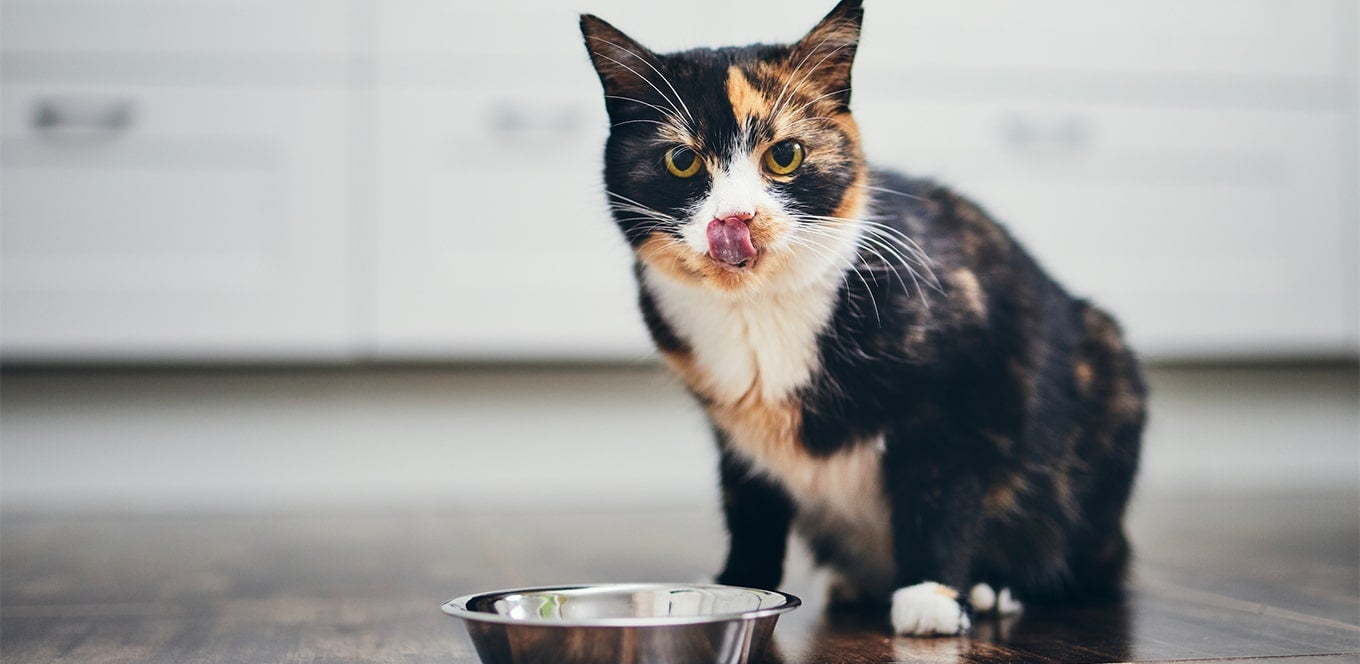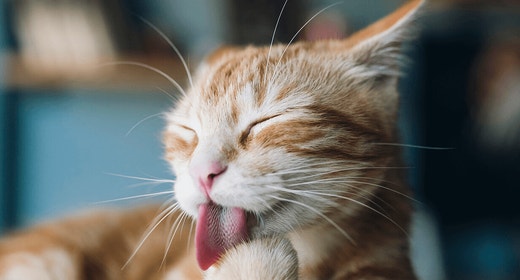

Knowing your cat needs a change in their diet is one thing, but knowing how to make that change is something else! Cats are creatures of habit, so it’s not uncommon for them to prefer their current food to anything new. Change disrupts their routine, which can impact their behavior and their digestion.
Thankfully, when the time has come to change your cat’s diet, a little planning and preparation goes a long way toward making the transition easier for them (and for you).
The following tips will help you change your cat’s diet and successfully transition your cat to a new food:
There are lots of reasons to consider changing your cat’s food — maybe you have a new kitten to wean, a kitten who’s all grown up now or an adult cat entering their senior years. In addition to normal aging, advice from the vet is a common reason to change what you’re feeding your cat. Cats that need help reducing their weight or managing excessive hairballs might need the support of a new food designed with those needs in mind. Whatever your reason for changing your cat’s diet, make sure the new food will suit their needs. That way you only have to make the transition once, and can avoid upsetting their stomach by changing the routine too often.
Going slow is paws down the most successful way to ease your cat into a different diet. Start by mixing 25% new food with 75% familiar food. Slowly change the proportions over the next three days or so by gradually increasing the amount of new food and decreasing the amount of their familiar food. Think of it as a kind of weaning — at the end of this process, you should be feeding (and your cat should be eating) just the new food.
Your cat may choose to eat only the familiar food, or not eat at all … at first. But a healthy cat can miss meals for a day or two without causing health problems. Slow, steady and consistent wins this race!
How would you feel if someone tried to force you to eat strange food you didn’t want?
Aggressively dumping the new food into your cat’s dish and declaring that your cat had better eat it might inspire your cat to do anything besides eat!
A little gentleness in your approach goes a long way. Try using a pleasant tone of voice and encouraging your cat to taste the new food. Even if they don’t go for it at first, a gentle approach still goes over much better than an aggressive one.
Cats train us as much as we train them. Giving in to their demands reinforces that their refusal to eat the new food is acceptable, which makes transitioning to the new diet even more challenging in the long run.
So don’t give up! Don’t be tempted to revert back to your cat’s familiar foods, and don’t give your cat treats or table scraps during the initial three-day period.
This is the toughest dietary transition of them all, but there are a few ways to make the process easier. If your cat resists eating dry food for more than a few meals, try mixing a little warm water with it and maybe even warming the moistened food in the microwave for a few seconds.
If you mix dry food with water, remember to discard any uneaten leftovers after 20 minutes to prevent spoilage. (The same rule applies for wet food.) After your cat is used to the moistened dry food, you can gradually transition to serving the same food dry.
Changing your cat’s diet is sometimes necessary to help them live a happy, healthy life. The process of switching what, how or how often you feed your cat can be a little bumpy, but you can do it! By going slowly, staying patient and encouraging, sticking to the plan and making the transition as easy as possible, you’ll be giving your cat what they need and helping them adjust as comfortably as possible.


An upset stomach is more common in cats than you might think. But how can you tell if it's a serious problem?
Every cat owner recognizes the warning signs of an upset feline stomach: the mournful meow, gagging, and heaving retch. But in a flash, the cat seems to snap back to good health while you're left scrubbing the carpet.
The scenario is a familiar one for Cynthia Bowen of Cleveland, Ohio. As the owner of four Maine Coons, Bowen has cleaned her share of messes. 'It would happen every couple of months or so,' she says. 'Otherwise, they were perfectly healthy.'
Although it's not a pleasant subject, vomiting is something cats seem to do almost on cue. Many cat owners accept this as a natural part of owning a pet, but it doesn't have to be that way. Knowing what triggers an upset stomach and what you can do about it will make for a better relationship with your cat.
Repeated cat vomiting should never be ignored because it can lead to dehydration. But, because vomiting is common in cats, how do you know what's normal? 'A general guideline is that if the cat is vomiting one to three times a month, we consider this 'normal,'' says Dr. William Folger, a DVM from Houston.
He considers it serious if the vomiting occurs twice daily for two or three days. If your cat stops eating, seems to have stomach pain, or retches continuously, or if there's blood in the vomit, take her to a veterinarian. And, as always, if you're suspicious that a lingering problem could be harmful to your pet, call your veterinarian. A visit to the office can help relieve your cat's discomfort and your worries as well.
Many owners attribute their cat's vomiting to hairballs, but that's not the only culprit. 'It's careless to assume that most cases of vomiting in cats are due to hairballs,' says Dr. Folger. Two other frequent causes of an upset stomach are:
Eating too fast. Cats sometimes eat too much, too fast. When the stomach wall expands too quickly, a signal is sent to the brain to cause regurgitation. In these cases, the mess on your floor is from regurgitation, not actual vomiting. When a cat regurgitates, he brings up fluid and food from his esophagus by opening his mouth–unlike vomiting, where there's gagging and retching. Regurgitated food is still formed, and may smell fermented. 'Cats that eat too quickly because they are gluttonous or stressed by food bowl competition can regurgitate right after eating,' says Dr. Sara Stephens, a DVM from Montana. But don't assume regurgitation is always a case of eating too fast. It could be caused by esophageal problems, obstruction of the digestive tract, hairballs, or dehydration. If you've forced your cat to eat slowly and he still has problems, contact a veterinarian.
Curiosity. Grass, carpet, and toilet paper are just a few things cats may digest and later vomit. The vomiting is a protective mechanism–nature's way of cleansing your cat’s system. Sometimes, though, curiosity can lead to more serious problems. String, toy parts, and feathers are favorites of playful felines and can lodge in the stomach or intestine, causing repeated vomiting and severe distress. If your cat exhibits these symptoms, take her to a veterinarian immediately; surgery is often necessary to remove the object.
Often, owners accept their pet's vomiting as a natural part of their behavior, but just because cats seem to have more than their fair share of tummy troubles doesn't mean you have to sit idly by.
One simple preventative measure is to get your fast-eating cat to slow down or to simply eat less. Stephens recommends smaller portions, elevating your cat's food dish slightly, or putting an object, such as a ball, into the dish. The cat will be forced to eat around the ball, and thus her intake will be slowed. If you do this, make sure the ball isn't small enough to swallow. And you may need to feed cats in a multiple-cat household at different times and places to reduce competitive eating.
If simple solutions don't work, watch your cat's eating behavior and reactions. Bowen, for example, tried changing her cats' diets. 'Since switching to IAMS®, they rarely throw up,' Bowen says.
'Usually, when you change to a higher-quality diet, there is no problem,' Stephens says. Here are some tips for helping make sure your cat's change is as successful and comfortable as possible:
Go slowly. Make the transition gradually to allow your cat time to adjust. 'Make sure the cat eats something every day,' Stephens advises. 'A cat that quits eating suddenly can develop liver problems.'
Measure up. How much should you feed? Your cat's age, sex, breed, activity level, and overall health need to be taken into consideration. Talk with your veterinarian, then read the manufacturer's recommendations. Premium foods like IAMS cat foods are more nutrient-dense than many non-premium diets, so don't be surprised if the recommended amounts seem low.
Pay attention. Beyond careful measuring, also regularly weigh your cat and adjust the feeding amount accordingly after switching to a premium food. Your cat may appear happy if you overfeed him. But over time, he may become overweight. Tummy troubles can be in the past with your veterinarian’s help and a little effort on your part.